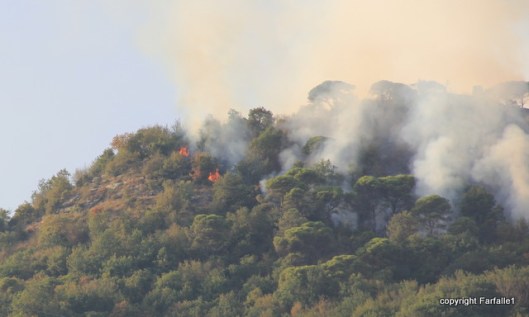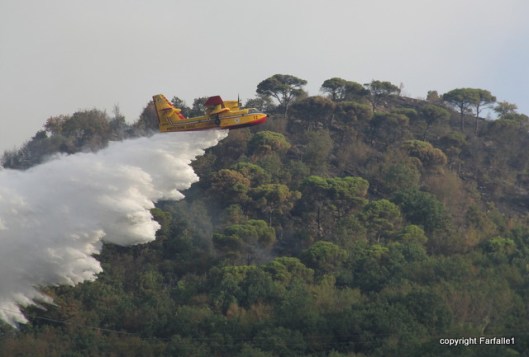Tags
Canadair, Corpo Forestale, Fighting forest fires in Italy, Fire Fighting planes, Forest fire in San Maurizio
(Click on photos to get larger, clearer images)
It’s been a fiery summer in both Europe and the U.S. We’ve had our own little bit of excitement here in San Maurizio, although nothing on the scale of the tragic fires in Spain or the numerous fires in western U.S.
It began Thursday. Speedy was home reading in the afternoon, and noticed there seemed to be a lot of helicopter traffic. He had a look around, and this is what he saw on the hillside behind us:
He kept track of the action all afternoon. First the wind blew to the east, then it swapped around and blew to the west. Two helicopters carried countless buckets of water to dump on the stubborn fires which, instead of going out, seemed to simply move on to another shrub or tree. With so many individual fires we wondered if this were arson. We don’t know, but we have been told the cause of the blazes is under investigation.
The ‘copter pilots are real sharp-shooters with their water buckets. I wondered, though: as they move slowly to a position above their target fire, do the rotors fan the blaze and undo some of the good the water is doing? In any event, they do some demanding and amazing flying and, more often than not, their bucketful of water lands right on the selected target.
The thing is, it looks like such a teeny amount of water – and so much effort is required to get it to the fire. It’s hard to imagine that it’s effective, but it is. By the end of the afternoon it looked like the fire was largely under control. The helicopters don’t fly at night, so it was good to see that the flames were out.
Or so we thought. I woke up at 3 a.m. and looked at the mountain to see it all ablaze again. This was disconcerting, and instead of going back to sleep I spent the rest of the night tossing, turning, and making a mental list of things to put into a box to carry away should it become necessary. Speedy spent his wakeful hour using GoogleEarth to compute how far the fire was from us. According to his calculations it was about 750 meters from our house as the cinder flies. It was less than 300 meters from the restored rustico of some friends. That’s too close!
Fortunately my list of what to pack was unnecessary. And the reason why is because, unbeknownst to us, there was a legion of volunteer firefighters (Vigilanza Antincendi Boschivi) on the ground, not only that night but during both days of the fire. It turned out that one of our acquaintances, who is too modest to allow me to use his name, is one of these volunteers, and he was able to give me some useful information.
The Corpo Forestale is in charge of organizing the fighting of fires outside of cities and towns. They decide which aircraft will be used (if needed) for each fire, and where and when the volunteers will go. There are two sizes of helicopter (ours was the smaller one) and the famous bright yellow Canadair airplanes (about which more shortly). The small helicopters carry what look like rather small buckets of water, though our friends says that when the water is mistakenly dumped on the volunteers it does not feel like a small bucket. The Canadairs carry a belly full of water, much more than the small buckets. We were told that the larger helicopter carries even more water than the plane, but we’ve never seen one. There are fires that don’t require aircraft, but forests in Italy tend to be on steep mountainsides; more often than not a plane or helicopter is the only way to get water to the fire.
The volunteers often work more on fire containment than actual fire-fighting; our friend said, however, that they did both with this particular fire. They hump in some heavy equipment and somehow manage to keep the fire from spreading. That is why, on Thursday night, the fire burned up the mountain instead of coming down towards the houses below and why, even though I watched, and heard, tree after tree go up in flames, the fire slowly abated so there was less of it as the sun came up. Thank you, VAB volunteers!
Daylight brought us a Canadair.
It is so exciting to watch these planes fly. They swoop down over the sea and fill up the plane’s belly with water, which they they carry back to the fire and release. There are moments, watching them, when it seems certain there is going to be a terrible mishap.
They use the plane’s inertia to propel the water where they want it to go. The pilot might, for instance, fly right at the side of the mountain, nosing up abruptly just before hitting, and releasing his water at the same time. The water goes straight into the mountain, and the plane, thank goodness, does not. Other times the pilot is able simply to drop his water as he goes (watch out, volunteers below!). Retired old pilot Speedy says it is no doubt very scientific, that the pilots are able to compute when to release the water based on air speed and altitude above target.
The Canadair, joined briefly by a second, grey plane, flew back and forth all morning. After lunch one small helicopter came back, and by the end of Friday it seemed the excitement was over. Our friend said he had been called to go back Saturday, but we saw no activity at ‘our’ fire. Perhaps he was out putting out other fires. Sadly, there’s no shortage of them at this time of year.
There are some more photos of the fire here, and I tried, for the first time, to make a video, which you can see here. (Sorry that it’s a little wobbly – next time I’ll use a tripod.) The most exciting part of the video is that you can hear the cock who can’t tell time (1 a.m., dawn, sunset: all the same to him), you can hear the loud sound that water meeting fire makes, and you can hear a short conversation between Speedy and myself. Very exciting. Unfortunately you won’t see the plane actually dumping water as that happened behind the mountain – but you can hear it (as well as the lovely low grumble of the twin engined plane).
The systems the Corpo Forestale have developed for fighting the numerous fires in Italy are admirable. The timely arrival and expertise of all the firefighters has surely saved millions of euros over the years (although the cost of fire-fighting with aircraft is extraordinary. The small helicopter, the 412, costs E 2,200/hour; the larger, the Ericson S64, costs E 7,000/hour and the Canadair costs E 10,000/hour.) What did they do before airplanes were invented? I suppose lots more forest burned. How lucky we are that we have helicopters with their little buckets and planes with their great big bellies. Given the choice, I guess I’d always choose the plane, just for the drama. But there’s an elegance to the helicopters, and a delicacy of approach which is also very appealing. Actually, I guess if my house/land were on fire I wouldn’t care who came, as long as he brought a lot of water with him!








Great post, Louise. What drama! I have often commented on your gift for photojournalism, and this is the perfect example. As for me, any fire I could see from my home would be a fire way too close for comfort! So glad you were not singed – many people in the western US have had their lives devastated by fire this year.
I know – and I don’t know why the fire wasn’t worse except a) there wasn’t wind to speak of and b) the forest is not particularly dense up there – mostly scrubby stuff and a lot of rocks. I sure thought a lot about Deborah, though, and how she lost everything. It would be horrid.
PS Thank you for saying nice things about my photojournalism – a pretty grand word for what I do, but thanks.
It has certainly been a bad year for forest fires and the terrible thing is that this year the fleet of Canadair fleet was reduced in size. 😦
I didn’t realize the fleet size had been reduced – part of austerity measures? Not good.
Glad to know you are all safe and sound.
Great pics!!! Perhaps you should send these into AP – could be a whole new career! So interesting to see the different planes and the water gushing out, but how scary for you and your neighbors. I’m so glad they got the fire under control! Do you have soot on your house or terrace? We were in Jamaica a few years ago and the flames of a local fire were so close the sparks were flying into our resort. The locals were unconcerned (typical Jamaican – “Don’t worry – be happy” which come from the great weed they smoke) but the roofs of our bungalows were thatch! I slept with my suitcase packed.
One year we spent part of our vacation at the beach in Scauri and I kept seeing this small plane landing in the sea and taking off shortly thereafter. This went on most of the day and stupid old me thought that the pilot was practicing sea landings and takeoffs for rescue purposes. That evening the friendly proprietor of “Lido Florida” enlightened me. Then the local news showed the planes in operation. Your story and pictures are great!!!
Thanks Gil. We were just talking to some friends this evening who once watched planes practicing picking up the water out in the bay. So your thought wasn’t so far off the mark – sometimes they do just that.
Hollywood is waiting for you !
Carmine & Wendy—Berkeley
Yay Hollywood! My bags are packed, I’m on my way!